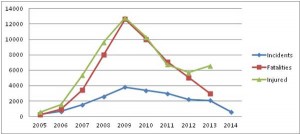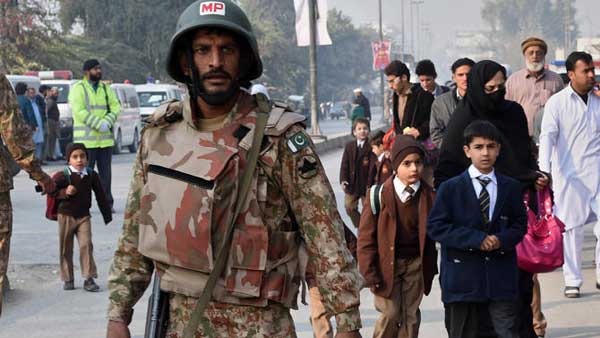IDR Blog
Peshawar Attack: Hitting at Soft Underbelly
The horrific attack on Army school at Peshawar on 16 December 2014 underscored the ruthlessness and the viciousness of leaders of Tehrik-i-Taliban (TTP). The attack purportedly against Pakistan Army’s operations in North Waziristan led to death of over 141 innocent children and civilians with almost 100 injured. The hideous attack also showed that the terrorists have no religion or sense of righteousness as they mindlessly killed children and unarmed civilians. It also highlighted that the relentless support to terrorist groups by Pakistan since the initial days of soviet occupation of Afghanistan has created a colossal mass of loosely regulated, unstable and armed militia which today has the capacity to attack any target or location with impunity. The soft approach against terrorist groups has also created a situation where the TTP and its elements have carried out brazen attacks against the Pakistani establishment since its formation in 2007.
Pakistan has continued to aid terror activities in India, by utilizing its so called strategic assets like JeM and LeT. This dual policy is likely to further de-stablise the internal security situation within Pakistan…
Nevertheless, Pakistan has continued to aid terror activities in India, by utilizing its so called strategic assets like JeM and LeT. This dual policy is likely to further de-stablise the internal security situation within Pakistan at a later stage due to conflicting loyalties. Pakistan has witnessed over 20,000 incidents[1] in last decade with terror attacks accounting for almost 70% of the total incidents. It has suffered over 50,338 fatal casualties and over 60,000 injured over since 2005. The period from 2008 to 2011 saw a sharp increase in terror activities as well as casualties within Pakistan. TTP’s terrorist actions accounted for 49% of the 1717 incidents in 2013 within Pakistan.
In an attempt to limit the terrorist groups, Pakistan has launched limited operations in the past backed with helicopter gunships, armed aircraft and heavy weaponry, which has often led to mass exodus from affected areas. These limited actions have not eliminated or contained terrorist groups due to lack of boots on the ground, and tribal loyalties in these restive areas.
 After coming to power in 2013, Nawaz Sharif government started peace talks with TTP to bring an end to insurgency. The peace talks predictably failed as TTP was buying time to re-group and Pakistan army launched Operation, Zarb-e-Azb in June 2014 in North Waziristan to eliminate TTP cadres. Achieving limited success, the operation led to displacement of almost one millions civilians, creating another humanitarian problem in Pakistan.
After coming to power in 2013, Nawaz Sharif government started peace talks with TTP to bring an end to insurgency. The peace talks predictably failed as TTP was buying time to re-group and Pakistan army launched Operation, Zarb-e-Azb in June 2014 in North Waziristan to eliminate TTP cadres. Achieving limited success, the operation led to displacement of almost one millions civilians, creating another humanitarian problem in Pakistan.
Time for Introspection
The loss of innocent lives should prompt introspection within the Pakistan Army. Its limitless arming and training to various terrorist groups to foment trouble in India has created a monolithic ogre, which today can unhinge their own security. Combined with indoctrinated elements within their own ranks, Pakistan has witnessed attacks on government and defence establishments like the Mehran Air Base incident, attack on Karachi airport and many more such cases in the past. Also, Pakistan Army’s India obsession has failed to accept the threat of home grown terror. In his Keynote address at International Defence Exhibition and seminar on 5 December 2014 at Karachi, the Pakistan Army Chief acknowledged that presence of non-state elements complicated the internal security situation in Pakistan and prevalent conflict mechanisms were unable to handle the terror threats. He still reiterated resolution of Kashmir[2] issue for regional peace.
Incidents of terrorism lead to anguish and also patronizing promises and pledges to eradicate terrorism as statements of Pakistani Prime Minister and Army Chief at Peshawar have indicated.
The Peshawar incident has shown that terrorism does not have any religion and terrorist groups will undertake any dastardly attack to fulfill their mandate. TTP elements were under pressure due to internal frictions and Zarb-e-Azb momentum and executed a low blow act by targeting the children. Today, Pakistan’s military leadership must accept the reality that the greater danger to Pakistan’s security lies from threats within rather than from India, which has made a number of peaceful gestures in the past even though it has been at the receiving end of mindless terrorism supported by Pakistani handlers and ISI elements.
The greater challenge for the leadership will be to make a concerted effort to act against the threat posed by the terrorist groups and focus its operations in FATA and Waziristan than towards India. Its military leaders can draw lessons from humane conduct of operations by Indian Army in Kashmir and Northeast India over the years where the thrust has been to avoid civilian casualties. Use of heavy weapons and helicopter gunships by Pakistan Army in Khyber, FATA and other restive provinces has led to mass exodus in the past and provided enough recruits for the terrorist organizations.
Likely Outcome
Incidents of terrorism lead to anguish and also patronizing promises and pledges to eradicate terrorism as statements of Pakistani Prime Minister and Army Chief at Peshawar have indicated. Though loss of innocent lives in Peshawar is deplorable, it is unlikely that Pakistan Army will reduce its India centric activities in the immediate future due to its inherent organizational focus as well as a means to maintain its hold over Pakistan’s foreign policy and large share of budgetary allocations. The relevance of Pakistan Army would tend to diminish if they reduced focus on India. Its support to terrorist groups will continue in the near future. It must be understood by Pakistan’s military leadership that till they acknowledge and take intensive steps to eliminate the terrorist groups, innocents will continue to pay the price for the general’s folly.
Courtesy: http://www.claws.in/
References
[1] Incidents include terror attacks, operations between security forces and militants, border clashes, political and ethnic violence and inter-tribal clashes. Data source: Annual Reports, Pakistan Institute of Peace Studies and SATP.
[2] http://www.thenewstribe.com/2014/12/04/army-chief-stresses-to-resolve-kashmir-palestine-dispute





